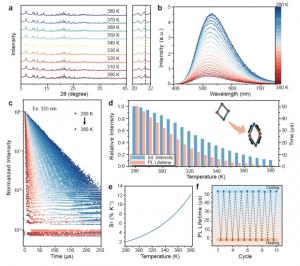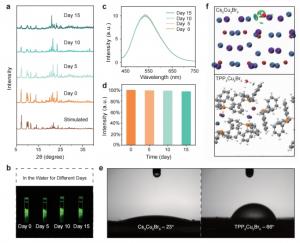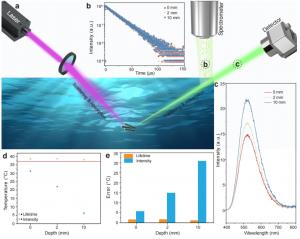Water Stable Hybrid Metal Halides for Sensitive Photoluminescence Lifetime Temperature Sensing

a, Temperature-dependent PXRD patterns of TPP3Cu2Br2. (b-d), Temperature-dependent PL properties of TPP3Cu2Br2. (e-f), Temperature sensing sensitivity and cycling stability.
FAYETTEVILLE, GA, UNITED STATES, June 26, 2025 /EINPresswire.com/ -- Metal halides generally suffer from poor stability and low temperature sensing sensitivity, which hampers their performance as optical thermometers. Recently, a research team led by Professor Xueyuan Chen from Fujian Institute of Research on the Structure of Matter, Chinese Academy of Sciences, has proposed a novel Cu(I)-based metal halide of TPP3Cu2Br2 by introducing the hydrophobic organic molecule triphenylphosphine (TPP), developing an excellent kind of water-stable and highly sensitive photoluminescence lifetime thermometer.
Optical thermometer is widely employed for temperature sensing by monitoring optical parameters like temperature-dependent changes in photoluminescence (PL) intensity or PL lifetime. Nevertheless, intensity-based optical thermometers like infrared thermal imager are susceptible to various factors including light source, sample concentration, photobleaching, scattering, and absorption at different wavelengths. PL lifetime proves advantageous for precise temperature sensing as it remains unaffected by the aforementioned factors. As such, PL lifetime-based thermometry fundamentally circumvents the inherent limitations of the conventional infrared thermal imager.
Organic-inorganic hybrid metal halides have emerged as excellent candidates for PL lifetime temperature sensing owing to their superior optical properties and the ability of organic molecules to induce crystal structures with "soft lattices". Nevertheless, the poor stability of metal halides, particularly their water stability, greatly restricts their applications. Therefore, the development of novel organic-inorganic hybrid metal halides with high temperature-sensing sensitivity and excellent stability is of critical importance.
In a recent paper published in Light Science & Application, the research team led by Professor Xueyuan Chen from Fujian Institute of Research on the Structure of Matter, Chinese Academy of Sciences, has designed and synthesized a novel kind of organic-inorganic hybrid Cu(I)-based metal halide TPP3Cu2Br2 by employing the hydrophobic organic molecule triphenylphosphine (TPP) as the A-site in the hybrid metal halides. Under ultraviolet light excitation, TPP3Cu2Br2 exhibited green emission with a PL quantum yield of 41.5%. Furthermore, the research team monitored the temperature-dependent structure variation of TPP3Cu2Br2. Drastic thermal expansion occurred with increasing temperature, resulting in the formation of additional defects that facilitated the rapid quenching of photoluminescence. As such, when the temperature rose from 280 K to 380 K, the PL intensity decreased to 10.8% of the initial value, while the PL lifetime dropped to only 1.9% of the initial value. The maximum relative sensitivity of temperature sensing based on PL lifetime reached as high as 12.8% K-1, representing the highest value among undoped metal halides-based luminescent thermometers. In addition, the stability for long-term use as a temperature probe was verified through cyclic testing (Figure 1).
By virtue of the protective effect of triphenylphosphine, TPP3Cu2Br2 displayed excellent water stability: after being soaked in water for 15 days, the luminescence of the sample remained 97.3% of its initial value. The significant contribution of TPP to water stability was verified through contact angle tests and theoretical calculations of binding energy compared to all-inorganic metal halide Cs3Cu2Br5 (Figure 2).
The research team further confirmed the superior accuracy of PL lifetime-based temperature sensing in water environments with different depths. The error read-out values of temperature sensing based on PL intensity significantly increased with increasing the water depth, reaching as high as 30.78 °C at 10 mm. By contrast, the PL lifetime-based sensing maintained excellent accuracy with an error of ~1 °C below 10 mm (Figure 3).
This work not only opens up a new path for the development of highly stable metal halides, but also provides a new idea for versatile intelligent sensing applications.
References
DOI
10.1038/s41377-025-01910-1
Original Source URL
https://doi.org/10.1038/s41377-025-01910-1
Funding Information
This work is supported by the National Natural Science Foundation of China (Nos. 22135008, 22275188, U22A20398, 12104455), Natural Science Foundation of Fujian Province (Nos. 2023I0032, 2022J05092).
Lucy Wang
BioDesign Research
email us here
Legal Disclaimer:
EIN Presswire provides this news content "as is" without warranty of any kind. We do not accept any responsibility or liability for the accuracy, content, images, videos, licenses, completeness, legality, or reliability of the information contained in this article. If you have any complaints or copyright issues related to this article, kindly contact the author above.


